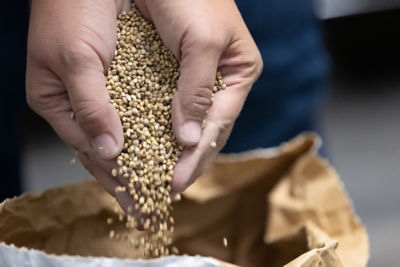Click here to download a PDF version of this spotlight.
» Vegetable crops need micronutrients in small amounts, but these nutrients are essential for normal plant growth and development.
» Micronutrient levels can cause nutrient deficiency or toxicity symptoms in plants if the levels are outside of their optimal range.
Plants absorb elements from their environment to use for growth and metabolic functions. The seventeen essential elements used by plants are divided into macronutrients and micronutrients, depending on the amount required by the plant. The term micronutrient does not imply that these elements are less essential than the macronutrients, just that smaller amounts are needed for normal plant growth.3 While individual macronutrients make up 0.4 to 90% of the dry weight of plant tissues, micronutrients usually make up 0.02% or less.1 The macronutrients include carbon (C), hydrogen (H), oxygen (O), nitrogen (N), phosphorus (P), potassium (K), calcium (Ca), sulfur (S), and magnesium (Mg). The micronutrients include iron (Fe), manganese (Mn), zinc (Zn), boron (B), molybdenum (Mo), copper (Cu), chlorine (Cl), and nickel (Ni).1
The availability of nutrients in a form that plants can absorb is dependent, in part, on the pH of the soil solution, with some nutrients being more available in acidic conditions (low pH) and others in alkaline conditions (high pH) (Figure 1). Plants usually take up nutrients in proportion to their levels in the soil. However, the overabundance of some nutrients can inhibit the uptake of certain other nutrients. For example, excess amounts of Ca can inhibit the uptake of Mg and B.1
 Figure 1. The effect of pH on the plant availability of six micronutrients.
Figure 1. The effect of pH on the plant availability of six micronutrients.
The location of nutrient deficiency symptoms on plants is affected by how mobile the elements are within the plant. An element that is highly mobile (easy for the plant to move) can be translocated from older tissues to younger developing tissues if levels in the plant are insufficient. So, for these elements, symptoms usually develop first on older tissues. Conversely, symptoms usually develop on younger tissues first with elements that are not very mobile in the plant.1,2,3
MICRONUTRIENTS
Iron (Fe): Iron is used in oxidation/reduction reactions in cells involved with photosynthesis and respiration. Iron is used in forming the chlorophyll molecule, cell division and growth, and nitrogen fixation in legumes.1,2,4 Deficiencies are usually the result of soil conditions rather than a lack of Fe in the soil. Fe is more available at low pH levels, and plant deficiency symptoms can develop in alkaline soil. Soil compaction, prolonged periods of excessive moisture, high temperatures and high levels of P, Cu, Mn, and/or Zn can result in Fe deficiency.5,6
Symptoms of Fe deficiency include interveinal chlorosis on leaves, with the chlorotic area becoming bleached and necrotic over time. Fe is not very mobile in the plant, so symptoms usually first develop on young leaves and stems.1,2,4 Suspected Fe deficiencies should be verified with tissue analysis. Deficiencies can usually be corrected by adjusting the pH levels and balancing the nutrient content of the irrigation solution. Foliar applications of chelated Fe can help to correct an Fe deficiency problem temporarily.1,4
Manganese (Mn): Manganese is used to help activate enzymes involved in growth processes, metabolism, phosphate transfer, and the electron transport system of photosynthesis. Uptake of Mn can be affected by high concentrations of Ca and Mg. Deficiencies of Mn are more likely to develop in waterlogged poorly drained soils, sandy soils low in organic matter, and soil pH levels over 6.0. The availability is also reduced in too acidic or too alkaline conditions.1,2,4,5,6
Manganese is relatively immobile in plants. So, deficiency symptoms usually develop first on the youngest leaves and stems. Interveinal regions of leaves become chlorotic with gray to black speckling. In some cases, symptoms may develop on older leaves first. Affected plants may develop an olivegreen discoloration.1,2,4,5 High levels of Mn can cause toxicity symptoms that are similar to deficiency symptoms.2,4,5 Correct the pH of the nutrient solution to manage Mn deficiencies. Foliar applications of Mn fertilizers can help temporarily correct deficiencies; however, some forms of Mn are insoluble and may not be effective as fertilizers.1,5,6
Zinc (Zn): Zinc acts as an enzyme cofactor-activator and is involved in the control of the plant growth regulator indoleacetic acid. Zn affects the formation of carbohydrates, including starch and seed production.1,2,4 The availability of Zn is reduced at very low and very high pH levels, and deficiencies are often associated with wet, cool, cloudy weather. High levels of P can also result in Zn deficiency in plants.4,5,6
Zn is not highly mobile in plants, and deficiency symptoms tend to develop first on the youngest leaves. Affected leaves show interveinal chlorosis, distortion, and puckered margins. Some plants may be stunted with shortened internodes.2,4 Zn-containing fertilizers include zinc chelate, zinc oxide, zinc oxysulfate, zinc polyfavonoids, and zinc sulfate.6
Boron (B): Boron is involved in cell membrane activity, differentiation of meristem cells, protein synthesis, cell wall formation, and pollen tube growth.1,2,4 Boron uptake can be affected by high concentrations of Ca, K, and N, with the ratio of Ca to B being the most important. Higher rates of B may be in clay soils with high pH or soils high in organic matter levels.4,6 Responses to B levels vary by crop, with Brassicas and root crops being the most sensitive. Boron is often found in animal manure and superphosphate fertilizers, which may contribute to B toxicity.5,6
Boron is not highly mobile in plants, and deficiency symptoms appear first on the youngest leaves and stems. Deficiencies can result in the breakdown of growing tips and shortened internodes, resulting in rosetting. Some crops show dark discoloration of internal tissues or the development of hollow stems. High levels of B can be toxic, causing yellow and necrotic spots on leaf margins and reduced root growth.1,2,4,5 Boron-containing fertilizers include borax and boric acid.6
Molybdenum (Mo): Molybdenum is involved in nitrate reduction and nitrate fixation and affects pollen formation.1,2 Mo is only needed by plants in small amounts, and deficiencies are rare if the soil pH is above 6.0. Deficiencies are mainly found in acidic, sandy soils in humid regions.2,5,6
Molybdenum deficiency symptoms include chlorosis of leaves, rolling, cupping, or scorching of leaf margins, and withering and crinkling of younger leaves. Brassicas may show irregular leaf blade formation and the development of whiptail of younger leaves. Toxicity from Mo is rare.2,4,5 Mo containing fertilizers include ammonium molybdate, molybdenum trioxide, molybdenum dioxide, and sodium molybdate.6
Copper (Cu): Copper is involved with photosynthesis, respiration, enzyme activation, metabolism, and lignin synthesis. The uptake of Cu is affected by Zn levels and pH. Cu deficiencies are rare, but more likely to occur in organic soils or mineral soils with high amounts of organic matter.1,2,4,5,6
Deficiency symptoms include chlorosis and dieback of the youngest leaves, wilting and developing a blue-green color, and some leaf elongation.2,4,5 There are many Cu-containing fertilizers, including copper sulfates, copper chelates, cupric ammonium phosphate, cupric chloride, cupric oxide, cuprous oxide, and copper polyflavonoids.6
Chlorine (Cl): Chlorine plays a role in charge balance within the cells and may be involved with photosynthesis and regulating cell turgor.1,4 Excesses of Cl are more common than deficiencies. Non-chloride fertilizers are often preferred to help keep Cl levels lower.1,4,6
Nickel (Ni): Nickel is believed to be involved with N metabolism and biological fixation. Deficiencies can cause leaf tip chlorosis and necrosis.4
MANAGING NUTRIENT REQUIREMENTS
Crop nutrient requirements (CRN) vary with the crop species, plant growth stage, and growth rate. Most vegetable crops should be supplied with low to moderate nutrient levels in the initial stages, with nutrient concentrations gradually increasing as the season progresses. The quality of the water used for irrigation/nutrient solutions can affect nutrient availability, so water should be tested periodically for pH, alkalinity, electrical conductivity (EC), and nutrient concentrations.4
Suspected nutrient deficiencies or toxicities should be verified through plant tissue analysis using the specific tissues recommended by the testing laboratory. Also, nutrient, pH, and EC levels in both the source solution and the root zone should be monitored to help detect potential nutrient problems. Foliar applications of some nutrients can be used to supplement nutrients taken up by the roots, but it is best to correct nutrient imbalances and problems with pH in the nutrient solution first. Wetting agents may be needed for foliar applications made to crops with waxy surfaces.3,5
SOURCES
1Sanchez, E., Di Gioia, F., Berghage, R., Flax, N., and Ford, T. 2023. Hydroponics systems and principles of plant nutrition: Essential nutrients, function, deficiencies, and excess. PennState Extension. https://extension.psu.edu/hydroponics-systems-and-principles-ofplantnutrition-essential-nutrients-function-deficiency-andexcess#:~:text=Macronutrients%20include%20carbon%2C%20hydrogen%2C%20oxygen,the%20amount%20required%20by%20plants.
2Taber, H. and Nair, A. 2016. Suggested soil micronutrient levels and sampling procedures for vegetable crops. Iowa State University Extension and Outreach, HORT 3063. https://www.extension.iastate.edu/vegetablelab/suggested-soil-micronutrient-levels-andsampling-procedures-vegetable-crops.
3Nutrition of greenhouse crops. Purdue University. https://www.purdue.edu/hla/sites/cea/wpcontent/uploads/sites/15/2021/01/Nutrition-ofgreenhouse-crops.pdf.
4Hochmuth, G. 2022. Fertilizer management for greenhouse vegetables—Florida greenhouse vegetable production handbook, vol 3. University of Florida IFAS Publication #HS787. https://doi.org/10.32473/edis-cv265-1990.
5Vitosh, M. 2015. Secondary and micro-nutrients for vegetable and field crops. Michigan State University, MSU Extension, Bulletin E486. https://www.canr.msu.edu/resources/secondary_and_micro_nutrients_for_vegetable_and_field_crops_e486.
6Micronutrients. Clemson University. https://www.clemson.edu/public/regulatory/ag-srvc-lab/soiltesting/pdf/micronutrients.pdf.
Websites verified 3/18/2025
ADDITIONAL INFORMATION
For additional agronomic information, please contact your local seed representative. Performance may vary, from location to location and from year to year, as local growing, soil and environmental conditions may vary. Growers should evaluate data from multiple locations and years whenever possible and should consider the impacts of these conditions on their growing environment. The recommendations in this article are based upon information obtained from the cited sources and should be used as a quick reference for information about vegetable production. The content of this article should not be substituted for the professional opinion of a producer, grower, agronomist, pathologist and similar professional dealing with vegetable crops.
BAYER GROUP DOES NOT WARRANT THE ACCURACY OF ANY INFORMATION OR TECHNICAL ADVICE PROVIDED HEREIN AND DISCLAIMS ALL LIABILITY FOR ANY CLAIM INVOLVING SUCH INFORMATION OR ADVICE.
5013_537050 Published 03/31/2025




